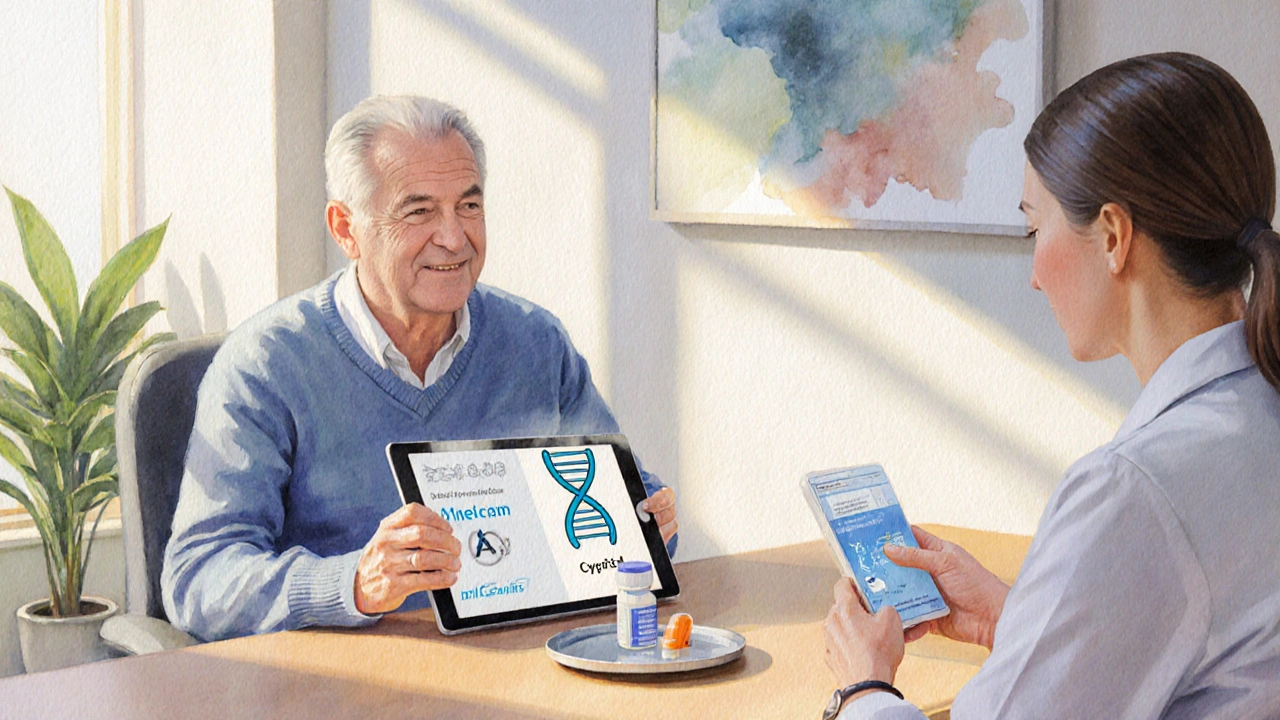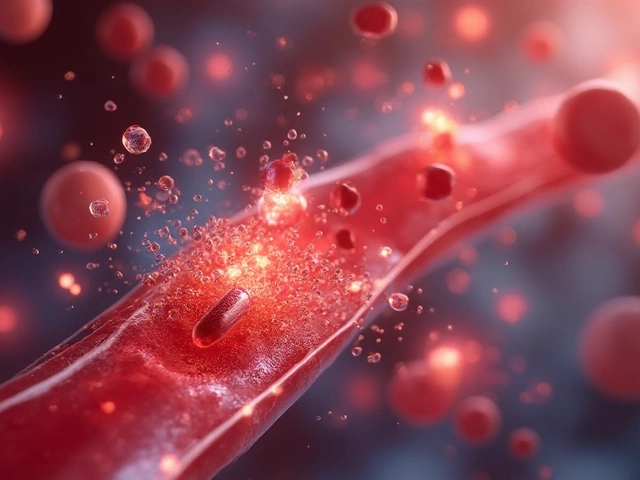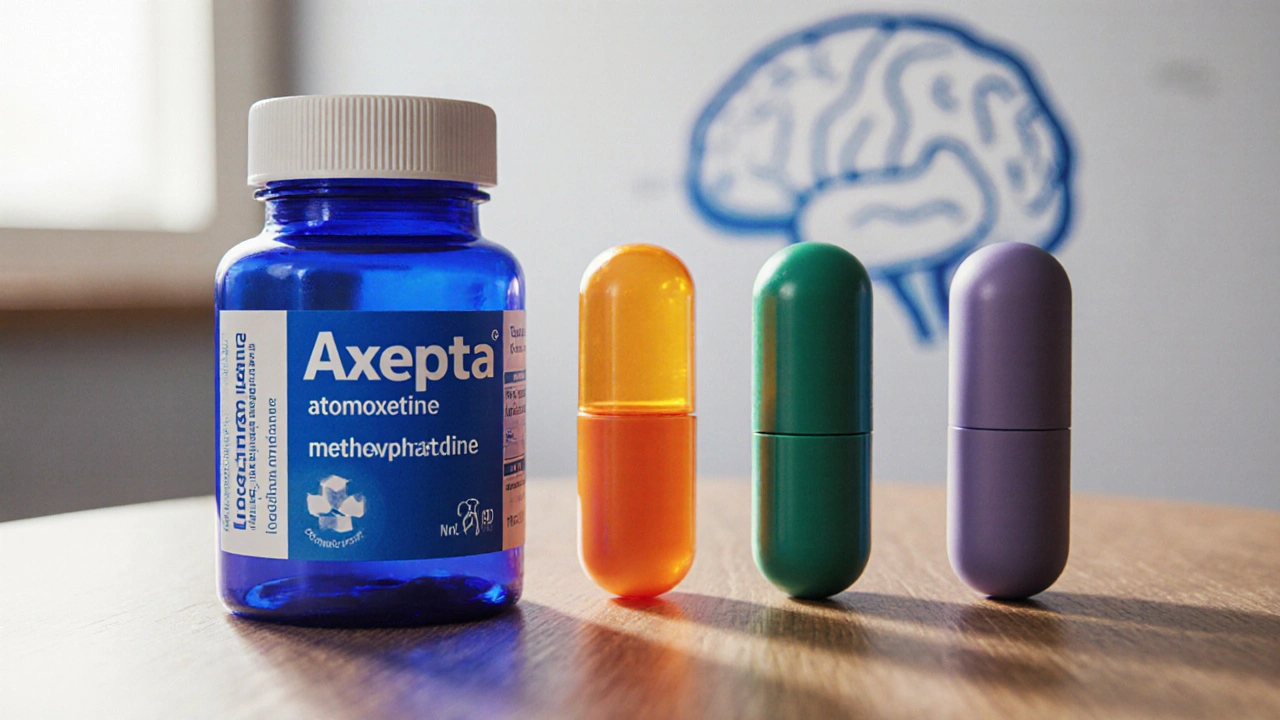ADHD Medication Comparison Tool
Find Your Best ADHD Medication Match
Answer a few questions to see which medication most aligns with your needs.
What matters most to you?
Key Takeaways
- Axepta (atomoxetine) is the only non‑stimulant approved for ADHD in adults and children.
- Stimulants (methylphenidate, lisdexamfetamine) act faster but can cause appetite loss, insomnia, and abuse potential.
- Guanfacine targets executive‑function symptoms and works well with either stimulant or non‑stimulant regimens.
- Genetic differences in CYP2D6 metabolism affect how patients respond to Axepta.
- Choosing the right drug depends on age, comorbidities, lifestyle, and personal preferences.
When you’re hunting for the right ADHD pill, the sea of options can feel overwhelming. Axepta is a non‑stimulant medication whose generic name is atomoxetine. It sits next to a lineup of stimulants and a few other non‑stimulants, each with its own quirks. This guide breaks down how Axepta measures up, who might benefit the most, and what the main alternatives bring to the table.
What Is Axepta (Atomoxetine)?
Atomoxetine belongs to the class of selective norepinephrine reuptake inhibitors (SNRIs). It was approved by the FDA in 2002 for children, adolescents, and adults with attention‑deficit/hyperactivity disorder (ADHD). Unlike stimulant drugs that boost dopamine instantly, Axepta raises norepinephrine levels gradually, which means it takes a few weeks to feel the full effect.
How Does Axepta Work?
Think of your brain’s neurotransmitters as traffic signals. Stimulants flip the green light for dopamine, while Axepta keeps the norepinephrine light green for a longer period. By blocking the norepinephrine transporter, atomoxetine increases the amount of norepinephrine that stays in the synaptic cleft, helping improve focus, impulse control, and emotional regulation.
One key piece of the puzzle is the liver enzyme CYP2D6. People who are “poor metabolizers” process atomoxetine more slowly, which can lead to higher blood levels and a greater chance of side effects. Your doctor may order a genetic test if you’ve had strange reactions to other meds.
Who Might Benefit Most from Axepta?
- Patients who can’t tolerate stimulants due to anxiety, insomnia, or a history of substance misuse.
- Those with co‑existing conditions like tic disorders, where stimulants may worsen symptoms.
- Individuals who need a steady, once‑or‑twice‑daily pill without the peaks and troughs of stimulants.
- People who prefer a medication that’s not classified as a controlled substance.
However, because Axepta takes 4-6 weeks to reach full efficacy, it’s not the best choice if you need rapid symptom relief for an upcoming exam or presentation.
Primary Alternatives to Axepta
Below are the most commonly prescribed ADHD drugs that sit on the opposite side of the spectrum.
- Methylphenidate - a short‑acting stimulant sold under brand names like Ritalin and Concerta. Works within 30‑60 minutes.
- Lisdexamfetamine - a pro‑drug that converts to dextroamphetamine (Vyvanse). Provides a smooth, 10‑14‑hour coverage.
- Guanfacine - an alpha‑2A adrenergic agonist used off‑label for ADHD, especially for “executive function” deficits.
Side‑by‑Side Comparison
| Attribute | Axepta (Atomoxetine) | Methylphenidate | Lisdexamfetamine | Guanfacine |
|---|---|---|---|---|
| Drug class | Selective norepinephrine reuptake inhibitor | Central nervous system stimulant | Stimulant pro‑drug (amphetamines) | Alpha‑2A adrenergic agonist |
| Onset of action | 1-2 weeks (full effect 4-6 weeks) | 30-60 minutes | 1-2 hours | 1-2 weeks |
| Duration | 12-24hours (once or twice daily) | 4-8hours (short‑acting) / 12hours (extended‑release) | 10-14hours | 8-12hours |
| Common side effects | GI upset, dry mouth, fatigue, sexual dysfunction | Insomnia, appetite loss, increased heart rate | Appetite loss, insomnia, anxiety | Drowsiness, low blood pressure, dry mouth |
| Controlled substance? | No | Yes (Schedule II) | Yes (Schedule II) | No |
| Typical dose range | 0.5-1.4mg/kg/day | 5-60mg/day (depends on formulation) | 30-70mg/day | 1-4mg/day |
Pros and Cons at a Glance
Axepta - Pros: non‑controlled, works for patients with anxiety or substance‑use concerns, steady blood levels, treats both kids and adults. Cons: slower onset, can cause liver‑enzyme elevations, metabolized by CYP2D6 (genetic variability).
Methylphenidate - Pros: fast relief, many formulations (short, intermediate, long‑acting). Cons: potential for abuse, may worsen anxiety or tics, appetite suppression.
Lisdexamfetamine - Pros: once‑daily dosing, smooth release, lower abuse potential than immediate‑release amphetamines. Cons: similar side‑effect profile to other stimulants, contraindicated in certain heart conditions.
Guanfacine - Pros: good for impulsivity and sleep issues, can be combined with stimulants, no abuse risk. Cons: may cause sedation, can lower blood pressure, less effective for core ADHD symptoms alone.
When to Pick Axepta Over a Stimulant
- History of substance misuse. Because Axepta isn’t a controlled substance, it sidesteps many legal and monitoring hurdles.
- Co‑existing anxiety or mood disorders. Stimulants can amplify anxiety; atomoxetine’s calmer profile often feels gentler.
- Concern about appetite loss. While Axepta can cause mild GI upset, it rarely hits the appetite as hard as stimulants.
- Need for a stable, once‑daily routine. No need to split doses or worry about “mid‑day crashes.”
If you ticked any of those boxes, bring Axepta up at your next appointment and ask about a trial period.

Practical Tips for Starting Axepta
- Start low (0.5mg/kg) and increase gradually; doctors often double the dose after 3 weeks if tolerated.
- Watch for liver enzyme tests at baseline and after 1-3 months.
- If you’re a poor CYP2D6 metabolizer, your doctor may keep the dose on the lower end.
- Give it at least 4 weeks before deciding it’s not working - the brain needs time to adjust.
- Keep a symptom diary (focus, impulsivity, mood) to discuss with your prescriber.
Frequently Asked Questions
Frequently Asked Questions
Can Axepta be taken with a stimulant?
Yes, doctors sometimes prescribe a low‑dose stimulant alongside Axepta to cover the early weeks or to manage breakthrough symptoms. This combo can balance the quick action of stimulants with the steady effect of atomoxetine.
What should I do if I miss a dose?
Take the missed tablet as soon as you remember, unless it’s almost time for your next dose. In that case, skip the missed one - double‑dosing can raise side‑effect risk.
Is Axepta safe for adults with heart conditions?
Atomoxetine can raise heart rate and blood pressure slightly. If you have uncontrolled hypertension or serious arrhythmias, your cardiologist and psychiatrist should weigh the risks versus benefits.
How long can I stay on Axepta?
There’s no predefined stop date. Many patients stay on atomoxetine for years, provided they continue to benefit and side effects remain manageable.
Will Axepta affect my sleep?
Some people report insomnia, especially if taken later in the day. Switching the dose to the morning often clears it up.
Do I need regular blood tests while on Axepta?
Baseline liver enzymes are recommended, then a follow‑up after 1-3 months. If values stay normal, routine labs aren’t usually required.
Can I switch from a stimulant to Axepta without a washout period?
Most clinicians recommend a short taper off the stimulant (1‑2 days) before starting atomoxetine to avoid overlapping side effects, but a strict washout isn’t always mandatory.
Bottom Line
If you need a medication that sidesteps abuse concerns, provides a stable once‑daily dose, and can be used alongside other ADHD treatments, Axepta is worth a serious look. For rapid symptom control or when cost is a major factor, stimulant options often win. The best choice lands somewhere between your clinical profile and personal preferences - talk openly with your healthcare provider and consider a short trial of each to see what feels right.




Comments
5 Comments
melissa hird
I must confess my fascination with how the medical establishment seems to love brand‑new acronyms as if they were culinary delights. The notion that Axepta can be the “non‑controlled” hero while stimulants race around like caffeinated squirrels is almost poetic, isn’t it? One could imagine a symposium where sociologists and pharmacists debate the ethics of naming drugs after mythical gods. Yet, beneath the pomp, the simple truth remains: patients need a steady option when the circus of stimulants gets too loud. So, raise a glass to the quiet one that finally lets a teenager finish breakfast without a side of hunger.
Abraham Gayah
Oh, the drama of choosing a pill! You think Axepta is some kind of mystical cure, but it’s just another excuse for pharma to cash in on “slow‑acting” hype. I’ll give it a pass until it can actually make me finish a Netflix binge without dozing off.
rajendra kanoujiya
Everyone’s gushing over non‑controlled status, yet the real issue is CYP2D6 variability that most clinicians ignore. If you’re a poor metabolizer, Axepta can turn your brain into a syrupy mess faster than a stimulant can. So, before you jump on the “safe” bandwagon, ask your doctor about a genetic test.
L Taylor
Imagine the brain as a river, the norepinephrine as its current. Axepta builds a dam that gently raises the water level over weeks, while stimulants unleash a flood in minutes. Both have merit, yet the patient’s patience determines which river you wish to navigate.
Matt Thomas
Look mate, Axepta ain’t some magic bean – it’s a slow‑poke that’ll make ya feel like you’re stuck in traffic. If ya need focus right now, grab a stimulant, not this “steady as she goes” nonsense. Stop wasting time reading charts, just ask your doc what works today.
Write a comment